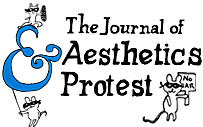
 |
 |
by Jene DeSpain
On March 20 2003, San Francisco hosted one of the most powerfully successful protests against war that the United States has ever witnessed. Thousands came together to take part in a beautifully masterminded menu of events, creating a web of human blockades that brought the city to a screeching halt. We divided the city into sections based on major traffic intersections and sites of war profiteering big businesses. Each section was occupied by its own affinity group and supporters taking control of the festivities transpiring there. Each location had its own dynamics. Each unit fed the fire that shut down San Francisco. We blockaded streets and buildings, we overloaded the jails to essentially crash the system by exceeding the numbers possible for the city to arrest. It was one of the most empowering days of my life.

Photo taken by Jeff Taylor, Video Activist Network
My friend Dan and I hit the streets around 11:30 AM after spending the last six hours at Justin Herman Plaza running communications (comm) with the orientation team- dispersing people through the city as needed. Having heard the action as it occurred over comm’s radios, we were restless, anxious, exhausted from days of sleep deprivation; we wanted the heat of the fight. So we set out into the city to join our fellow demonstrators with comm’s radios, cell phones, gas masks, and bullhorns slung around our chests.
As we moved south into the heart of downtown, we were immediately confronted by multiple groups of protestors being assaulted by citizens who were outraged at the actions. I saw people in lockdown being pushed and screamed at by people who worked in the downtown. I saw drivers jump out of their cars to harass and threaten the safety of people sitting in blockades. Dan and I continued to walk down Market Street towards the Federal Building; we stopped at Kearney Street where we meet a group of four men and a woman wrestling a newspaper vending machine out of the arms of a single protester. Both sides were shouting at each other, shoving one another to the cement, struggling to get control of the news box. It’s clear someone was going to get hurt. I approached the group and quickly deescalate the situation using standard nonviolent tactics.
Throughout the day, Dan and I were challenged by continued conflicts between demonstrators and other citizens. The most horrific was a man with his SUV running into demonstrators who were walking along Polk Street. It was a scary situation and luckily we were able, as a group, to get safely out of the path of this particularly aggressive driver. Dan and I were able to calm down multiple situations of verbal, physical, and political disagreement; I relied heavily upon deescalation tactics and persistent communication with both fellow protestors and members of the wider public.
Common ways to communicate nonviolence in potentially dangerous situation are referred to as deescalation tactics. These tactics are easy to remember and are great ways to bring people back to sensibility. Some standards are;
* Putting yourself between the people in conflict. Look people in the eye,
get their attention, ask them what is happening, speak slowly and directly.
Allow people a moment to discover why they are behaving the way they are
with each other.
*Whistle, sing, clap, sit down, create a physical space that has a different
energy than violence. Use yourself as a deflection device to the situation
that they are creating.
*Encourage protestors in conflict to move on. Sometimes a quick reality check
is all is needed to disarm an argument.
*Lock arms with people being singled out. Let it be known to both parties
that support is present. Ask people their names, why they are there, bring
the situation to a personal, humane level.
* Most importantly try not to panic. remain calm, move and speak slowly.
Listen without getting defensive, remain unbiased. and understand that our
actions as demonstrators affect other people outside of our group and be
attentive to everyone's space.
It is an incredible feeling to join in solidarity with thousands of people
in public spaces to communicate to our undemocratic government our dissent.
It is empowering, passionate and pertinent that we voice our opposition.
Yet when we place ourselves in the streets, we must be aware that we will
face conflict from the government, the police force and sometimes the public.
Communication during emotionally heated situations can be extremely difficult.
It can be very helpful to arm ourselves with nonviolent communication tactics.
After all, community begins with us. We have to be accountable to the people
who we live with before we can be accountable to communities across the
globe.
Nonviolent demonstration is an effective way to communicate our heart felt opinions to this country. Let us riot loudly, flood the streets of this country with justice, practice the behavior that we demand of politicians and war-makers everywhere- Peace!!
SEE YOU IN THE STREETS!